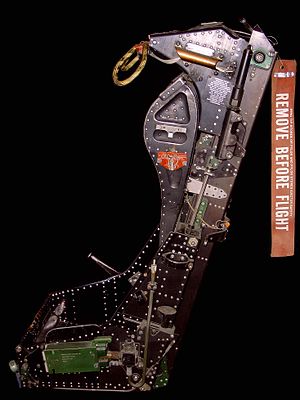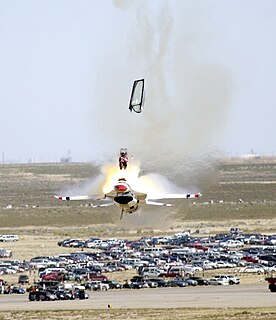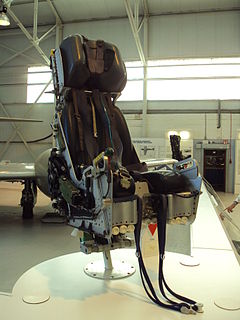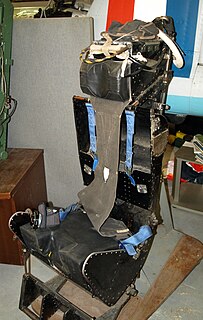| Mk.5 | |
|---|---|
 | |
| Side view of a Martin-Baker Mk.5 |
The Martin-Baker Mk.5 is a British ejection seat designed and built by Martin-Baker. Introduced in the late 1950s, the Mk.5 has been installed in combat and training aircraft worldwide. [1]
| Mk.5 | |
|---|---|
 | |
| Side view of a Martin-Baker Mk.5 |
The Martin-Baker Mk.5 is a British ejection seat designed and built by Martin-Baker. Introduced in the late 1950s, the Mk.5 has been installed in combat and training aircraft worldwide. [1]
The Mk.5 seat was developed alongside the Mk.4 design to meet the needs of the United States Navy. Compared to the Mk.4 seat the structure and harnesses were strengthened to withstand higher crash landing loads, this resulted in a slight increase in weight. [2] Canopy breaking horns were added to allow ejection through an unjettisoned canopy. [2] Two aircraft types operated by the Royal Norwegian Air Force, the RF-84F Thunderflash and the F-86D Sabre, were retro-fitted with Mk.5 seats at the Martin-Baker company's home airfield at Chalgrove. [2]
Operating either the seat pan or face blind firing handles initiates aircraft canopy jettison, the main gun located at the rear of the seat then fires, the main gun is a telescopic tube with two explosive charges that fire in sequence. As the seat moves up its guide rails an emergency oxygen supply is activated and personal equipment tubing and communication leads are automatically disconnected, leg restraints also operate. [2]
A steel rod, known as the drogue gun, is fired and extracts two small parachutes to stabilise the seat's descent path. A barostatic mechanism prevents the main parachute from opening above an altitude of 10,000 ft (3,000 m) A time delay mechanism operates the main parachute below this altitude in conjunction with another device to prevent the parachute opening at high speed. The seat then separates from the occupant for a normal parachute descent, a manual separation handle and ripcord is provided should the automatic system fail. [2]
The Mk.5 ejection seat has been installed in the following aircraft types:
List from Martin-Baker. [2]

In aircraft, an ejection seat or ejector seat is a system designed to rescue the pilot or other crew of an aircraft in an emergency. In most designs, the seat is propelled out of the aircraft by an explosive charge or rocket motor, carrying the pilot with it. The concept of an ejectable escape crew capsule has also been tried. Once clear of the aircraft, the ejection seat deploys a parachute. Ejection seats are common on certain types of military aircraft.
Martin-Baker Aircraft Co. Ltd. is a British manufacturer of ejection seats and safety-related equipment for aviation. The company's origins were originally as an aircraft manufacturer before becoming a pioneer in the field of ejection seats. The company's headquarters are in Higher Denham, Buckinghamshire, England with other sites in France, Italy and the United States.

The Republic F-84 Thunderjet was an American turbojet fighter-bomber aircraft. Originating as a 1944 United States Army Air Forces (USAAF) proposal for a "day fighter", the F-84 first flew in 1946. Although it entered service in 1947, the Thunderjet was plagued by so many structural and engine problems that a 1948 U.S. Air Force review declared it unable to execute any aspect of its intended mission and considered canceling the program. The aircraft was not considered fully operational until the 1949 F-84D model and the design matured only with the definitive F-84G introduced in 1951. In 1954, the straight-wing Thunderjet was joined by the swept-wing F-84F Thunderstreak fighter and RF-84F Thunderflash photo reconnaissance aircraft.

The Republic F-84F Thunderstreak was an American swept-wing turbojet fighter-bomber. While an evolutionary development of the straight-wing F-84 Thunderjet, the F-84F was a new design. The RF-84F Thunderflash was a photo reconnaissance version.

The Hellenic Air Force Museum was founded in 1986 and since 1992 has been located on Dekelia Air Base in Acharnes north of Athens. In opposition to the War Museum of Athens it displays air force history and is active in restoring and presenting old aircraft. Most aircraft in the collection come from the Hellenic Air Force; some were exchanged with other European aircraft museums.

The Militaire Luchtvaart Museum was located at Camp Zeist near the former Soesterberg Air Base. It was the official museum of the Royal Netherlands Air Force.

The Italian Air Force Museum is an aircraft museum at Vigna di Valle, on Lake Bracciano (Lazio), in central Italy. It is operated by the Aeronautica Militare. The museum's collection has an emphasis on Italian machines and seaplanes. While maintaining the technical and historical aspects, the museum is also dedicated to the influence aviation has had on Italian art, featuring works by Futurist painters Pietro Annigoni, Giacomo Balla, and Tato; and contemporary art such as Flight: Papiers froissés by Antonio Papasso.

ACES II is an ejection seat system manufactured by the Collins Aerospace division of Raytheon Technologies (RTX). ACES is an acronym for Advanced Concept Ejection Seat. It is used in Fairchild Republic A-10 Thunderbolt II, McDonnell Douglas F-15 Eagle, General Dynamics F-16 Fighting Falcon, Lockheed Martin F-22 Raptor, Lockheed F-117 Nighthawk, Rockwell B-1 Lancer, WB-57, and Northrop Grumman B-2 Spirit aircraft. Over 10,000 ACES II seats have been produced with over 5,000 actively flying throughout the world as of 2013. It is known throughout the industry as the lowest life cycle cost third generation seat due to the USAF owning the rights to the seat, facilitating competitive replacement part procurement. In addition, the buying power of 5,000 in-service seats and previous service life extension programs have further driven down support costs.

The Martin-Baker Mk.7 is a British rocket-assisted ejection seat designed and built by Martin-Baker. Introduced in the mid-1960s, the Mk.7 has been installed in combat aircraft worldwide.

The Martin-Baker Mk.6 is a British rocket-assisted ejection seat designed and built by Martin-Baker. Introduced in the 1960s, the Mk.6 has been installed in combat and training aircraft worldwide.

The Martin-Baker Mk.4 is a British ejection seat designed and built by Martin-Baker. Introduced in the 1950s, the Mk.4 has been installed in combat and training aircraft worldwide.

The Martin-Baker Mk.9 is a British rocket-assisted ejection seat designed and built by Martin-Baker. Introduced in the late-1960s, the zero-zero capable Mk.9 has been installed in several European combat aircraft types and was also used in experimental aircraft.

The Martin-Baker Mk.10 is a British rocket-assisted ejection seat designed and built by Martin-Baker. Introduced in the 1970s, the zero-zero capable Mk.10 has been installed in many combat aircraft types. A lightweight version is known as the Mk.10L.

Martin-Baker Mk.8 is the designation given to two distinct British ejection seat types designed and built by Martin-Baker. The original use applies to a seat developed for the cancelled BAC TSR-2 strike aircraft project of the 1960s, re-use of the designation applies to a lightweight version of the Martin-Baker Mk.10 seat for the Short Tucano and other similar military training aircraft.

The Martin-Baker Mk.1 is a British ejection seat designed and built by Martin-Baker. Developed in the late 1940s it was the first in the line of production Martin-Baker seats for military aircraft. Ground and air testing of earlier designs resulted in the first successful test ejection of a company employee in July 1946. A seat type designed for the Saunders-Roe company was known as the Pre-Mk.1.

The Martin-Baker Mk.2 is a British ejection seat designed and built by Martin-Baker. Introduced in the early 1950s, the Mk.2 was developed from the Martin-Baker Mk.1, the main improvement being automatic seat separation and parachute deployment.

The Glenn L. Martin Maryland Aviation Museum is located at Martin State Airport in Middle River, Maryland. It educates visitors through the use of exhibits, artifacts, archival materials and stories about aviation in Maryland over the last hundred years, with an emphasis on the Glenn L. Martin Company and the more recent Lockheed Martin histories.
ML Aviation was a British aerospace company. Until 1946 it was R Malcolm & Co, taking its new name from the businessman Noel Mobbs and the aircraft designer Marcel Lobelle.
| Wikimedia Commons has media related to Martin-Baker Mk.5 . |